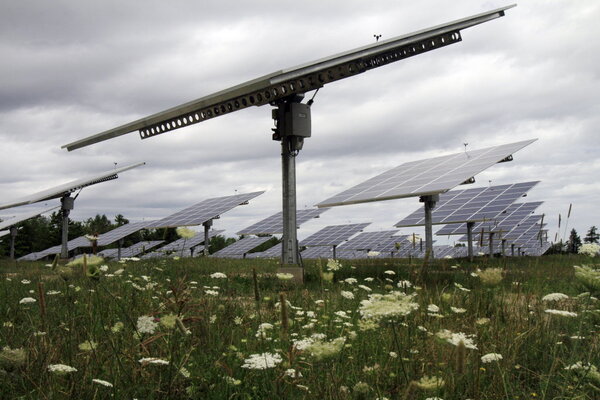Yes, it is. Exactly what we've been reporting on for 2 years. Clean tech and clean energy will help lead the green economy to rapid and, we hope, sustained growth.
Solar power: the next energy jobs juggernaut?
Solar power is emerging as an important job creator in a shifting energy economy.
The US energy and climate debate has long been framed as a competition between jobs and the environment. It’s the high-polluting energy sources that buoy national employment figures, the standard thinking goes, while clean power does little to promote economic growth.
That dynamic is changing. As the price of solar power continues to plummet – and the costs of extracting oil, gas, and coal continue to rise – solar is emerging as a significant job creator in a shifting energy economy.
To be sure, solar accounts for less than 1 percent of the country’s total energy mix. Taken together, fossil fuels power most of the economy and support a sprawling labor force from coast to coast. Still, one out of every 83 new jobs created economy-wide in 2015 was in the solar industry, according to a report released this week by the Solar Foundation, a nonprofit research organization based in Washington. In 2015 the solar energy sector employed 208,859 people, adding 35,052 new jobs from the year before, on par with the level of growth of the previous two years.
This rosy picture stands in stark contrast with the forecast for the fossil fuel industry, which is struggling in a changing energy landscape. While there are still estimated to be millions of jobs in the oil and gas sectors – including a plethora of support and administrative positions – the actual extraction of oil and gas is experiencing much less growth than the solar industry as a whole, analysts say.
The coal mining industry, too, hampered by new environmental regulations and increased competition from the natural gas sector, is quickly losing steam. According to a report in the journal Energy Policy, the coal industry lost around 50,000 jobs from 2008 to 2012. It now employs fewer than 70,000 people, according to the Solar Foundation.
The solar industry, however, grew by 123 percent over the past five years, maintaining around 20 percent growth each year for the past three.
The falling cost of solar energy combined with a growing concern for global warming is spurring the growth of the industry, experts say. In Sept. 2015 the US solar industry surpassed the 20 gigawatts installed capacity milestone for the first time. Residential solar, also known as rooftop solar, grew the most.
Some of this expansion can be attributed to new models for accessing solar.
Tax credits, for example, have given the industry a boost by lowering the cost of installation. US businesses and homeowners can receive a tax credit of around 30 percent if they install solar panels.
“Several years ago the only way to get solar if you were a homeowner was to take out a loan or pay with cash,” explains Ms. Luecke. “Now there is third party ownership and there are companies that do clean energy bonds, as well as other financing models.”
California and Massachusetts currently have the most employees working in the solar industry due to the solar-friendly legislation in these states, but the Solar Foundation notes that jobs are being created in every state across the country.
And industry experts say the growth is likely to continue. Solar companies are expected to create around 30,000 new jobs in 2016.


No comments:
Post a Comment